https://www.youtube.com/watch?v=NTBRThwL-2c
The Best Chicken Breast You'll Ever Make (Restaurant-Quality) _ Epicurious 101
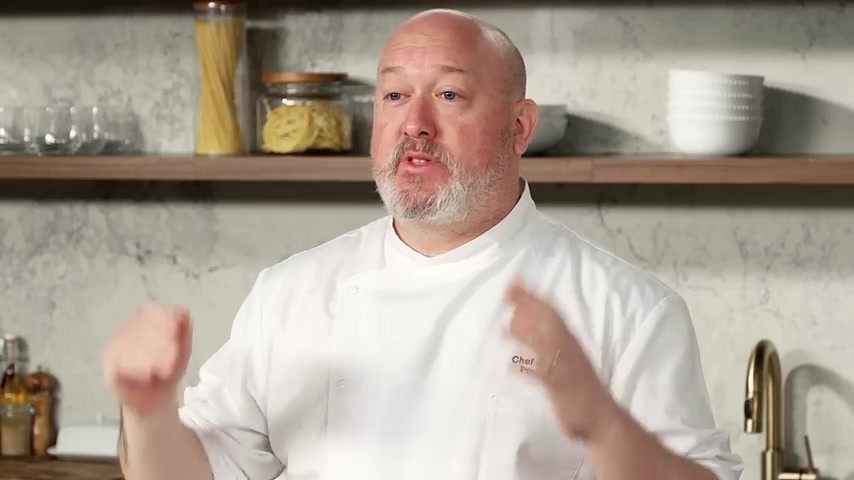
I'm Frank Proto , a professional chef and culinary instructor .
And today I'm gonna show you how to make a perfectly juicy chicken breast .
Frank style .
We're talking succulent delicious chicken breast .
Not that dry stringy stuff that your grandma serves .
This is chicken breast .
101 chicken breast doesn't need to be dry and stringy with a little bit of knowledge .
A little bit of technique .
It could be juicy and delicious .
Every single time in front of me , I have two different chicken breasts .
One is a little smaller .
One is a little larger .
I try and go for the smaller ones .
I feel like they're more tender .
They have a better texture .
This chicken breast , I'm gonna leave alone .
This chicken breast needs a little work before we can put it in the pan .
I'm gonna take this chicken breast and I'm just gonna get my chef knife , put a flat hand on top and I kind of cut it right down the center .
You'll notice that when I put my hand on top , my thumb is kind of pointed up , my fingers are pointed up .
I'm just putting light pressure down .
That light pressure will make it easier to cut .

And now we basically have two chicken breasts from the one I feel like this is a better size to cook .
If it's too thick , it takes a little longer .
You get dry ends and the center is usually a little pink .
So this way , it's gonna cook much more evenly .
Some people will tell you pound this out with a meat mallet .
I don't really like to do that because I want my chicken breast to be nice and brown .
And if I pound it out and then saute it , it's gonna be way overcooked by the time it's ready to eat when it comes to seasoning chicken breasts .
I'm a minimalist .
Salt and pepper .
Only spice rubs tend to burn when you saute them .
When you're sauteing a chicken breast , you wanna make sure that before you put it in the pan , you get a paper towel and pat it dry .
That extra moisture will stop our chicken from browning .
So get all that excess moisture off before you put it in the pan .
When I season , I use Kosher salt and fresh cracked black pepper .
Whenever you season , you want to start really high .
If I was to season like this , you get little spots of salt .

If you season high , you get a nice even distribution of salt pepper .
Go a little bit on a fine grind with this and then we can turn it over and season the other side .
You wanna season both sides chicken season ready to go .
Let's cook .
I have a stainless steel saute pan in front of me .
I like these because they're a bit of a thicker gauge .
They're heavy bottom , stainless steel saute pan .
If you have a thin saute pan , what happens is you get burnt spots and undercooked spots .
I like to use cast iron for a lot of things like this .
But when I'm doing a pan sauce , I don't like cast iron because believe it or not , it gets a little of that flavor from the pan .
Why you stay on the steel ?
There is no flavor transfer from the pan to the sauce .
When sauteing , you want high temperature for a shorter amount of time .
You see , I put salt on this chicken breast salt draws out moisture .
So before we go in the pan again , you want to dab this to make sure they're not wet .
This way , we ensure proper browning .
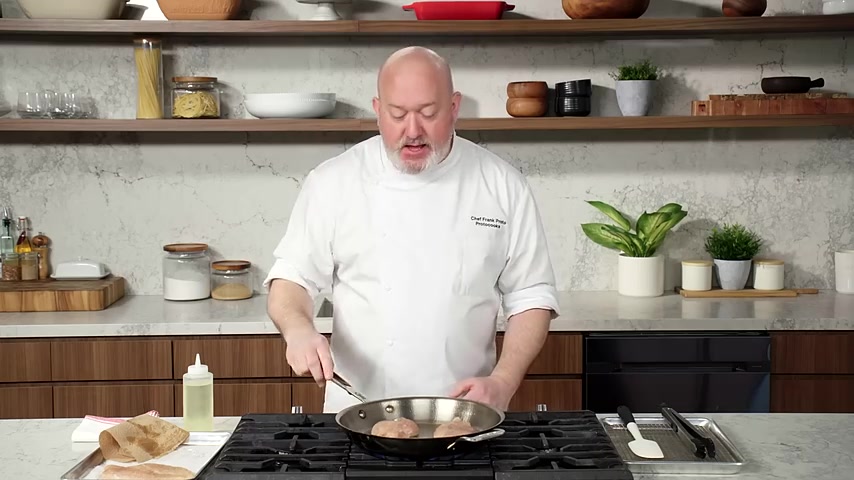
My pan is getting hot .
I like to use a neutral high smoked point oil .
We're just using a vegetable oil here .
I don't use fancy oils for this because once they go in the pan , all the flavor disappears and you can see right away .
It looks like waves .
It looks kind of shimmery and that's what I want .
If there's a little bit of smoke , that's a good thing .
I'm gonna dab off my chicken breasts and then when I drop them in the pan , I'm dropping away from myself .
If I drop it towards myself , I'm getting splashed with oil .
If I drop it away from myself , I am not getting splashed with oil to lower my heat down .
A little .
Don't be afraid to adjust your heat if you have to .
Right now .
I feel like I have the right amount of heat .
I took a quick peek underneath to see that I was browning .
My chicken wasn't sticking .
But for the most part , at this point , you want to just leave it alone .
Let the saute pan do its work .
Don't mess around , don't move it around too much .
You can check occasionally to see how you're doing right .
We're getting some nice browning in there .
Don't mess around with it too much .
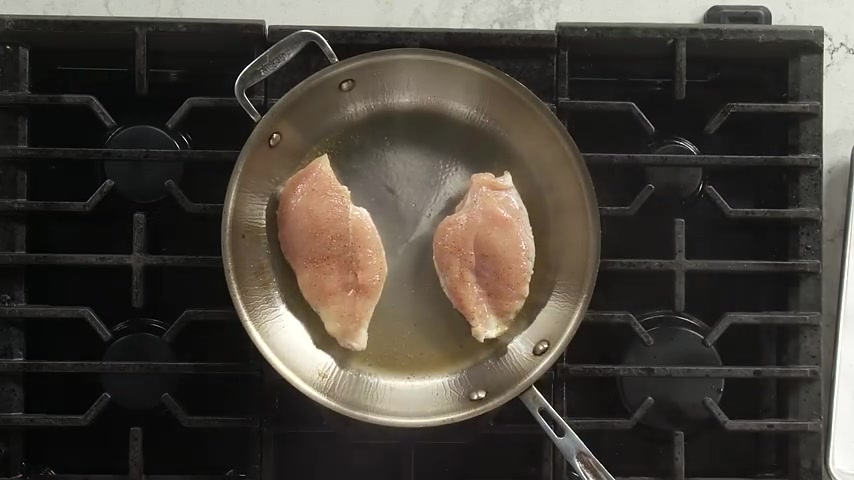
Leave it alone .
I have a little bit of a dry spot here because the pan is a little boat in the middle .
So the oil kind of went to the edges .
So you'll notice that I always want my chicken breast to be sitting in the oil .
What this does is I don't have high spots and low spots .
My chicken cooks nice and even on the surface , what I'm looking for here is that we have a nice golden brown on that side .
Look at that .
That's beautiful .
And then what I'm doing is I'm poking my chicken breast .
I know that it's raw .
But as they poke onto it , it's super soft and as it cooks to the right temperature .
It's going to go from super soft and kind of spongy to being really bouncy .
And that's what I'm looking for .
The texture of it .
Right .
I don't want it to be soft and spongy .
I want it to kind of bounce back really nice .
You'll notice that I only have two breasts in here .
I have a third .
But I think that if I put too many in the pan , it's going to overcrowd the pan .
What happens basically is it starts to steam , steam is moisture and then your chicken breast does not get brown .
So don't overcrowd your pan .
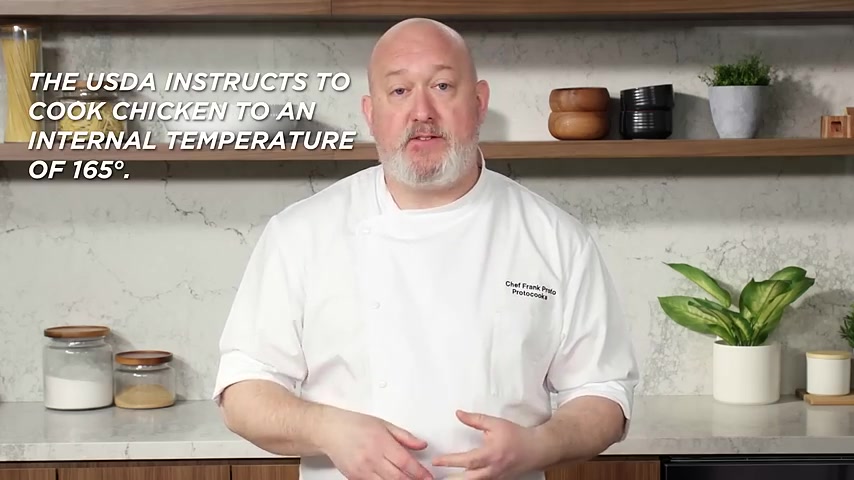
I feel like this chicken breast is ready to go if you touch it .
It's got some nice bounciness to it .
I'm going to take it out and put it onto my resting rack .
This piece is a little thicker .
It needs a little more time .
You notice that I use my fingers because I have chef hands .
You can always just push down with tongs to see how your bounciness is .
Most people say that chicken breast needs to be cooked about 16 five in order for it to be fully cooked .
I find if chicken breast gets cooked to 165 it's dry .
I tend to go about 151 150 five because they will continue to cook .
When you put them over here .
It's called carry over cooking .
If you're really unsure about when to take it off .
You can always use a thermometer .
I kind of go by touch and feel , even if it's a little pink or a little underdone , we can always reheat it before we put the sauce on it .
Right now .
I'm getting some nice good bring back .
I'm gonna take this out and let it rest .
I put my chicken on the resting rack so the meat can kind of equalize the juices can redistribute and we'll have a nice juicy chicken breast .
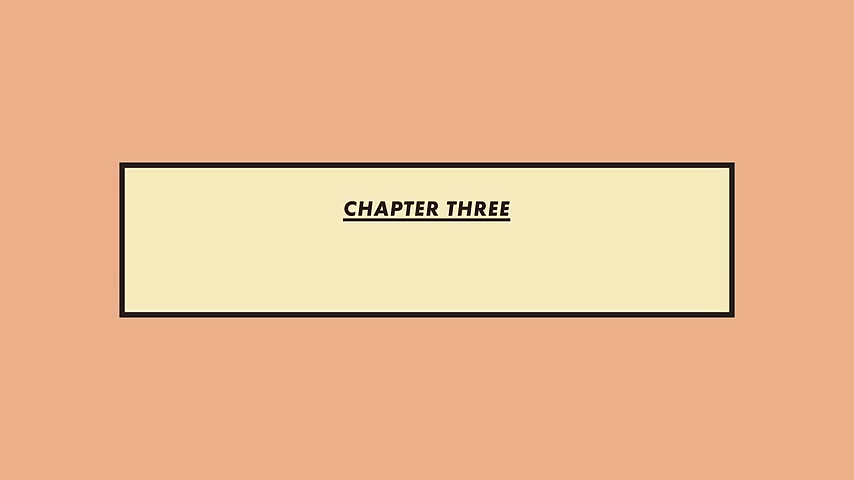
So you can see my chicken breast is nice and brown .
It's got some nice caramelization and that equals flavor .
I have some of my juices running off .
I can always reclaim those if I want .
Part of the reason why chicken breast is so easy to mess up is because it's a super lean cut of meat .
There's little to no fat on it .
Unless you keep the skin , it's gonna be a dry piece of meat .
So cooking it properly is where it's at for our chicken breast .
Today , we're gonna do a super simple pan sauce that anyone can make .
You don't need to be a culinary genius to get this right .
If you're sauteing chicken breast , a pant sauce is your friend in restaurants .
Pant sauces don't really get made because they take a lot of time .
But this is a great for the home cook .
The star of the show here is that fond and that is really necessary for a good pan sauce .
A fond is all the caramelized juices in the bottom of the pan .
It's super flavorful .
It's gonna give color to your sauce .
Uh and it's just gonna make it taste great .
So my pan is getting hot .
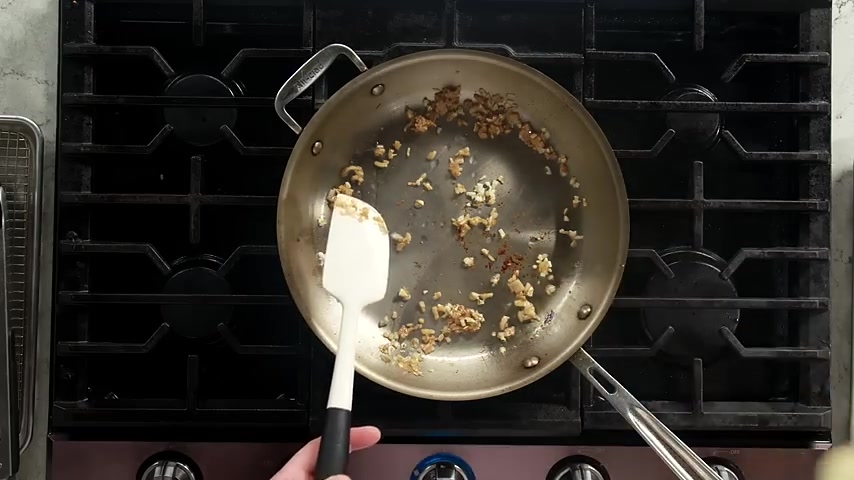
I'm gonna put just a little bit of fresh oil .
Not a lot .
So I have about a couple of shallots here .
Diced nice and fine .
So you'll notice that I cook my shallots a little before I add my garlic .
I have a couple of cloves of garlic .
There pans a little dry .
So I'm just gonna add a little more oil because I want these to sizzle and get nice and caramelized and brown .
So now my garlic and shallots are nice and brown .
I'm gonna add chicken stuff .
It stops the cooking of my shallots and garlic and that's gonna be the main flavor base .
We're gonna reduce .
This down reduction is a really great way to get flavor chicken stock by itself isn't super flavorful .
But if you reduce it , you get a really nice chicken flavor .
It's probably gonna take about 7 to 8 minutes to reduce .
You gotta be patient here .
Take your time .
I turn my heat up a little because I want this to , to a simmer really quickly .
Any chicken juices that you have should be put in there , not oil , but the juice that juice comes out of the chicken while it rests , that should be put in your sauce .
Do not waste that .
So we're gonna let this come to a simmer .
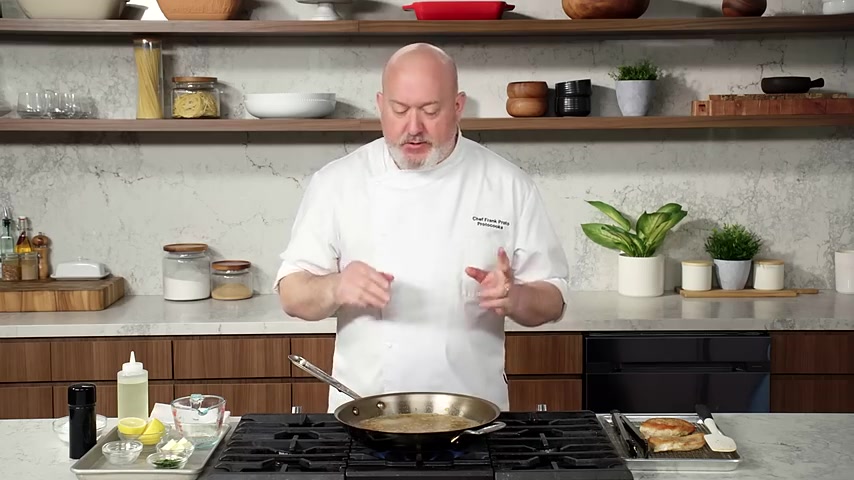
You'll see that it's starting to come to a boil .
And if you look at my bubbles here , my bubbles are really small and fine as you reduce things like chicken stock , you'll notice that it starts to get a little thicker and the bubbles get a little bit bigger and that'll tell you your sauce is getting to the right consistency .
Just watch the bubble at this point .
I'm gonna add just a pinch of salt .
I'm not gonna go crazy with the salt because we're reducing this .
If you season this all the way right now and then you reduce it .
It's gonna be way too salty .
A little salt , a little pepper and then we'll readjust later on when the sauce is close to being done , the sauce is reduced by half .
I add my butter and that's , that's what I want .
I want the butter to incorporate into the sauce at this point .
I'm making sure that I got everything off the bottom of the pan and then I'm just gonna mix it up so you can actually see my bubbles on the side getting bigger .
My sauce is getting thick thicker .
The butter emulsifies into the sauce and makes it creamy and delicious .
The classic French term for this is Monte A or to mount with butter .
I'm gonna adjust and lower my heat and let this go a little slower .
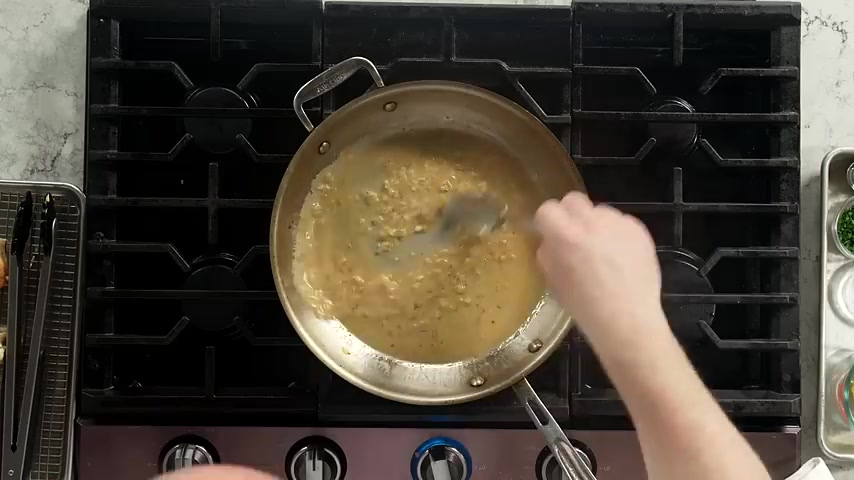
So you can see my sauce is starting to get thick .
But what I'm looking for is that nape consistency .
And if I put my spoon in there and I run my finger through , can still see that it's a little liquid .
It's not really sticking to my spoon , but I want this to kind of stick to my spoon and get a little thick .
Right .
So you can see we have considerably less liquid than we did earlier .
What I'm gonna do is I'm gonna turn my heat on super low .
Uh I'm gonna hit it with some lemon juice .
One thing that I like to do is take the cut side and put it on my hand and when I squeeze , I squeeze towards my hand so that the seeds get trapped in between my hand and the lemon half .
I like to add the lemon juice at the end because I want to be fresh and bright .
I don't want really cooked lemon juice flavors just a little more seasoning salt and pepper .
I'm gonna swirl that around .
So the sauce is ready and this is what I'm looking for .
There's a lot less liquid in this pan , right ?
The sauce looks creamy .
It's thick .
I coat the back of my spoon .
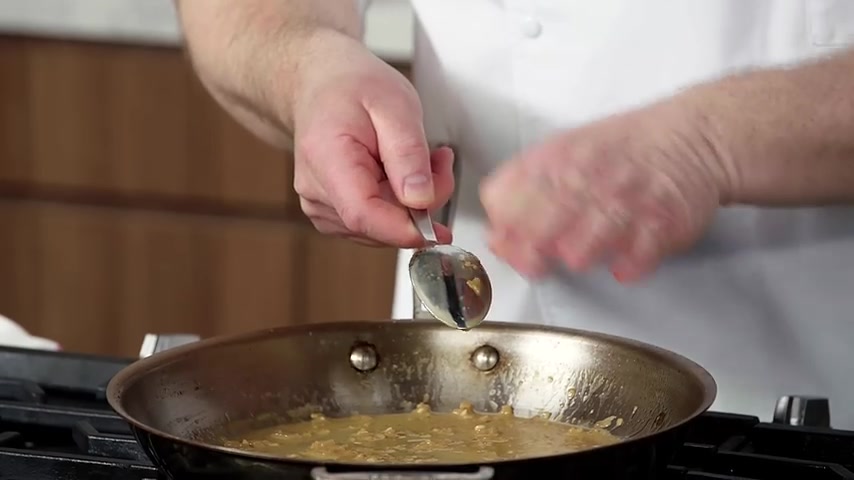
I run my finger through , there's a very sharp line and you can see on either side the sauce is stuck to my spoon .
And what you can do now is add some parsley .
Parsley has had a really nice bright fresh flavor to it .
I like to add it right at the end .
Most people add parsley just for color .
I love the flavor .
But look at that .
See how much sauce we have .
It's not a lot but it's nice and thick .
It's got a nice creamy consistency and that's our pant sauce .
The pan sauce is done , the chicken is rested .
It is time to plate .
Now , I like to slice my chicken breast just to give it a little more visual peel so we can see the inside of it .
One thing that I always focus on here is this end piece .
No matter what I do , this end piece is gonna be a little dry .
So what I like to do is cut that chef snack .
Now with our chicken breast , I wanna slice on a nice long angle .
You can see inside it's not dry .
It's still got some bounce to it .
It's juicy and delicious .
Not overcooked .

I like to put the pan sauce on the bottom of the plate because if you take that pant sauce and put it on top , you're kind of hiding that nice browning that you did .
Not only that , it's kind of crispy and you're gonna take away that crispiness .
That's a chicken breast .
I wanna eat time to taste .
Let's get in there .
You can see that it's nice and soft and tender .
It is not dry .
And stringy .
Whenever I eat a chicken breast like this , the sauce is key mop up the sauce as much as you can .
By the end of this , your plate should be totally clean .
Chicken breast can be delicious .
It just takes a little technique .
A little bit of know how and patience it can be juicy .
I promise you .
Are you looking for a way to reach a wider audience and get more views on your videos?
Our innovative video to text transcribing service can help you do just that.
We provide accurate transcriptions of your videos along with visual content that will help you attract new viewers and keep them engaged. Plus, our data analytics and ad campaign tools can help you monetize your content and maximize your revenue.
Let's partner up and take your video content to the next level!
Contact us today to learn more.